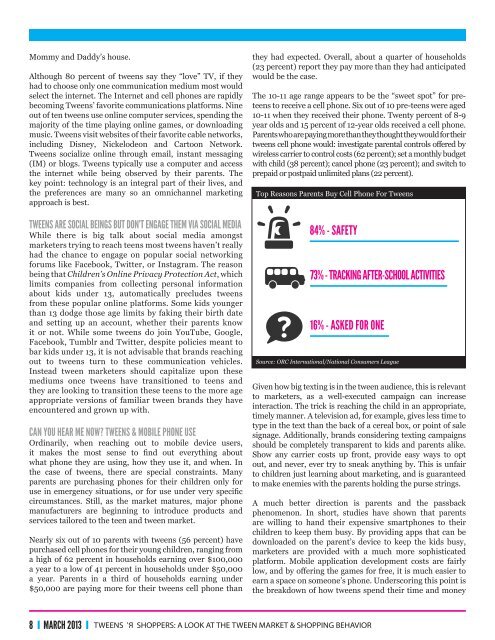You also want an ePaper? Increase the reach of your titles
YUMPU automatically turns print PDFs into web optimized ePapers that Google loves.
R’<br />
Mommy and Daddy’s house.<br />
Although 80 percent of tweens say they “love” TV, if they<br />
had to choose only one communication medium most would<br />
select the internet. The Internet and cell phones are rapidly<br />
becoming <strong>Tweens</strong>’ favorite communications platforms. Nine<br />
out of ten tweens use online computer services, spending the<br />
majority of the time playing online games, or downloading<br />
music. <strong>Tweens</strong> visit websites of their favorite cable networks,<br />
including Disney, Nickelodeon and Cartoon Network.<br />
<strong>Tweens</strong> socialize online through email, instant messaging<br />
(IM) or blogs. <strong>Tweens</strong> typically use a computer and access<br />
the internet while being observed by their parents. The<br />
key point: technology is an integral part of their lives, and<br />
the preferences are many so an omnichannel marketing<br />
approach is best.<br />
TWEENS ARE SOCIAL BEINGS BUT DON’T ENGAGE THEM VIA SOCIAL MEDIA<br />
While there is big talk about social media amongst<br />
marketers trying to reach teens most tweens haven’t really<br />
had the chance to engage on popular social networking<br />
forums like Facebook, Twitter, or Instagram. The reason<br />
being that Children’s Online Privacy Protection Act, which<br />
limits companies from collecting personal information<br />
about kids under 13, automatically precludes tweens<br />
from these popular online platforms. Some kids younger<br />
than 13 dodge those age limits by faking their birth date<br />
and setting up an account, whether their parents know<br />
it or not. While some tweens do join YouTube, Google,<br />
Facebook, Tumblr and Twitter, despite policies meant to<br />
bar kids under 13, it is not advisable that brands reaching<br />
out to tweens turn to these communication vehicles.<br />
Instead tween marketers should capitalize upon these<br />
mediums once tweens have transitioned to teens and<br />
they are looking to transition these teens to the more age<br />
appropriate versions of familiar tween brands they have<br />
encountered and grown up with.<br />
CAN YOU HEAR ME NOW? TWEENS & MOBILE PHONE USE<br />
Ordinarily, when reaching out to mobile device users,<br />
it makes the most sense to find out everything about<br />
what phone they are using, how they use it, and when. In<br />
the case of tweens, there are special constraints. Many<br />
parents are purchasing phones for their children only for<br />
use in emergency situations, or for use under very specific<br />
circumstances. Still, as the market matures, major phone<br />
manufacturers are beginning to introduce products and<br />
services tailored to the teen and tween market.<br />
Nearly six out of 10 parents with tweens (56 percent) have<br />
purchased cell phones for their young children, ranging from<br />
a high of 62 percent in households earning over $100,000<br />
a year to a low of 41 percent in households under $50,000<br />
a year. Parents in a third of households earning under<br />
$50,000 are paying more for their tweens cell phone than<br />
they had expected. Overall, about a quarter of households<br />
(23 percent) report they pay more than they had anticipated<br />
would be the case.<br />
The 10-11 age range appears to be the “sweet spot” for preteens<br />
to receive a cell phone. Six out of 10 pre-teens were aged<br />
10-11 when they received their phone. Twenty percent of 8-9<br />
year olds and 15 percent of 12-year olds received a cell phone.<br />
Parents who are paying more than they thought they would for their<br />
tweens cell phone would: investigate parental controls offered by<br />
wireless carrier to control costs (62 percent); set a monthly budget<br />
with child (38 percent); cancel phone (23 percent); and switch to<br />
prepaid or postpaid unlimited plans (22 percent).<br />
Top Reasons Parents Buy Cell Phone For <strong>Tweens</strong><br />
84% - SAFETY<br />
73% - TRACKING AFTER-SCHOOL ACTIVITIES<br />
16% - ASKED FOR ONE<br />
Source: ORC International/National Consumers League<br />
Given how big texting is in the tween audience, this is relevant<br />
to marketers, as a well-executed campaign can increase<br />
interaction. The trick is reaching the child in an appropriate,<br />
timely manner. A television ad, for example, gives less time to<br />
type in the text than the back of a cereal box, or point of sale<br />
signage. Additionally, brands considering texting campaigns<br />
should be completely transparent to kids and parents alike.<br />
Show any carrier costs up front, provide easy ways to opt<br />
out, and never, ever try to sneak anything by. This is unfair<br />
to children just learning about marketing, and is guaranteed<br />
to make enemies with the parents holding the purse strings.<br />
A much better direction is parents and the passback<br />
phenomenon. In short, studies have shown that parents<br />
are willing to hand their expensive smartphones to their<br />
children to keep them busy. By providing apps that can be<br />
downloaded on the parent’s device to keep the kids busy,<br />
marketers are provided with a much more sophisticated<br />
platform. Mobile application development costs are fairly<br />
low, and by offering the games for free, it is much easier to<br />
earn a space on someone’s phone. Underscoring this point is<br />
the breakdown of how tweens spend their time and money<br />
8 MARCH <strong>2013</strong> TWEENS<br />
SHOPPERS: A LOOK AT THE TWEEN MARKET & SHOPPING BEHAVIOR


